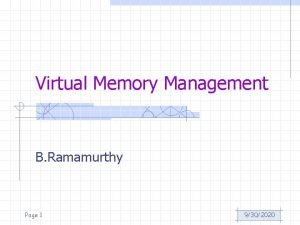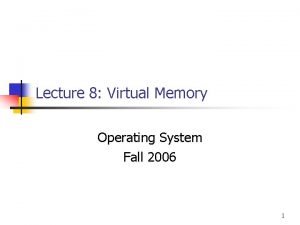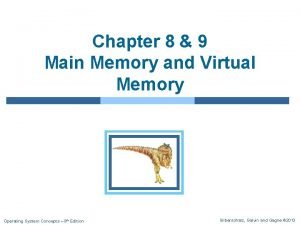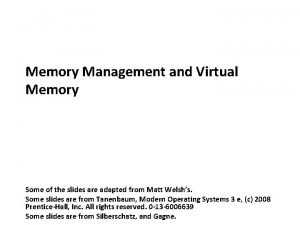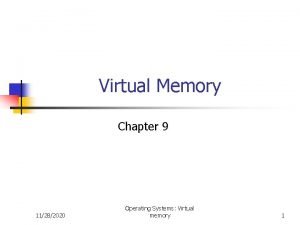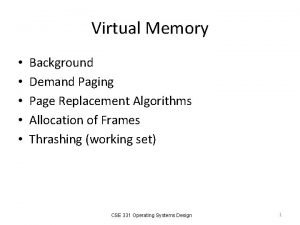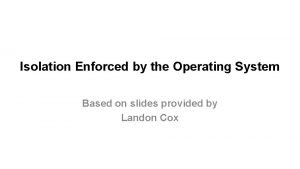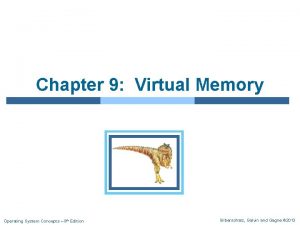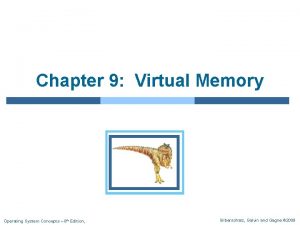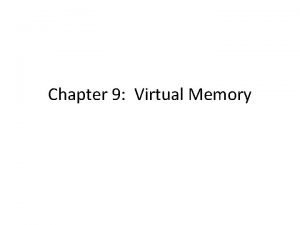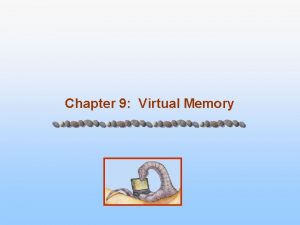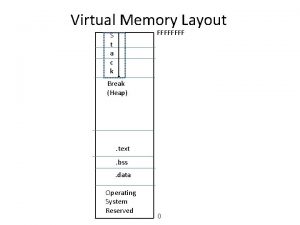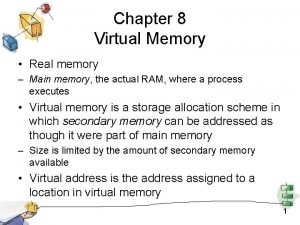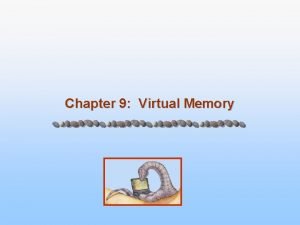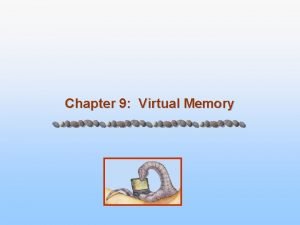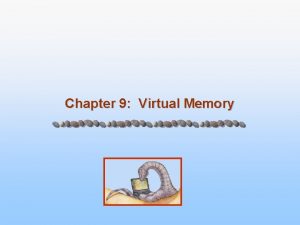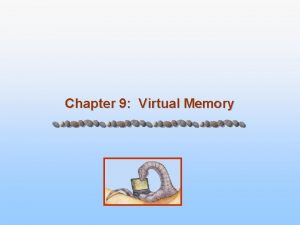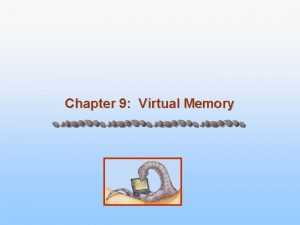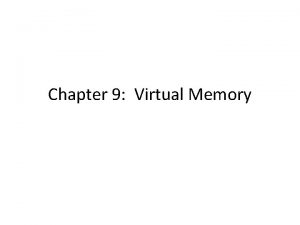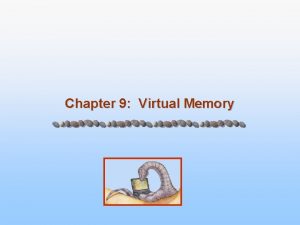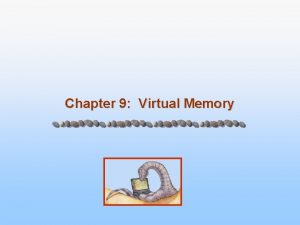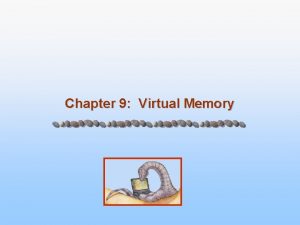Chapter 8 9 Main Memory and Virtual Memory





























- Slides: 29

Chapter 8 & 9 Main Memory and Virtual Memory Operating System Concepts – 9 th Edition Silberschatz, Galvin and Gagne © 2013

Background n Program must be brought (from disk) into memory and placed within a process for it to be run n Main memory and registers are only storage CPU can access directly Operating System Concepts – 9 th Edition 8. 2 Silberschatz, Galvin and Gagne © 2013

Base and Limit Registers n A pair of base and limit registers define the logical address space n CPU must check every memory access generated in user mode to be sure it is between base and limit for that user Operating System Concepts – 9 th Edition 8. 3 Silberschatz, Galvin and Gagne © 2013

Binding of Instructions and Data to Memory n Address binding of instructions and data to memory addresses can happen at three different stages l Compile time: If memory location known a priori, absolute code can be generated; must recompile code if starting location changes l Load time: Must generate relocatable code if memory location is not known at compile time l Execution time: Binding delayed until run time if the process can be moved during its execution from one memory segment to another 4 Need hardware support for address maps (e. g. , base and limit registers) Operating System Concepts – 9 th Edition 8. 4 Silberschatz, Galvin and Gagne © 2013

Logical vs. Physical Address Space n The concept of a logical address space that is bound to a separate physical address space is central to proper memory management l Logical address – generated by the CPU; also referred to as virtual address l Physical address – address seen by the memory unit n Logical and physical addresses are the same in compile-time and load-time address-binding schemes; logical (virtual) and physical addresses differ in execution-time address-binding scheme n Logical address space is the set of all logical addresses generated by a program n Physical address space is the set of all physical addresses generated by a program Operating System Concepts – 9 th Edition 8. 5 Silberschatz, Galvin and Gagne © 2013

Memory-Management Unit (MMU) n Hardware device that at run time maps virtual to physical address n The user program deals with logical addresses; it never sees the real physical addresses l Execution-time binding occurs when reference is made to location in memory l Logical address bound to physical addresses Operating System Concepts – 9 th Edition 8. 6 Silberschatz, Galvin and Gagne © 2013

Paging n Physical address space of a process can be noncontiguous; process is allocated physical memory whenever the latter is available l Avoids external fragmentation l Avoids problem of varying sized memory chunks n Divide physical memory into fixed-sized blocks called frames l Size is power of 2, between 512 bytes and 16 Mbytes n Divide logical memory into blocks of same size called pages n Keep track of all free frames n To run a program of size N pages, need to find N free frames and load program n Set up a page table to translate logical to physical addresses n Backing store likewise split into pages n Still have Internal fragmentation Operating System Concepts – 9 th Edition 8. 7 Silberschatz, Galvin and Gagne © 2013

Address Translation Scheme n Address generated by CPU is divided into: l Page number (p) – used as an index into a page table which contains base address of each page in physical memory l Page offset (d) – combined with base address to define the physical memory address that is sent to the memory unit l For given logical address space 2 m and page size 2 n Operating System Concepts – 9 th Edition 8. 8 Silberschatz, Galvin and Gagne © 2013

Paging Model of Logical and Physical Memory Operating System Concepts – 9 th Edition 8. 9 Silberschatz, Galvin and Gagne © 2013

Paging (Cont. ) n Calculating internal fragmentation l Page size = 2, 048 bytes l Process size = 72, 766 bytes l 35 pages + 1, 086 bytes l Internal fragmentation of 2, 048 - 1, 086 = 962 bytes l Worst case fragmentation = 1 frame – 1 byte l On average fragmentation = 1 / 2 frame size l So small frame sizes desirable? l But each page table entry takes memory to track l Page sizes growing over time 4 Solaris supports two page sizes – 8 KB and 4 MB n Process view and physical memory now very different n By implementation process can only access its own memory Operating System Concepts – 9 th Edition 8. 10 Silberschatz, Galvin and Gagne © 2013

Shared Pages n Shared code l One copy of read-only (reentrant) code shared among processes (i. e. , text editors, compilers, window systems) l Similar to multiple threads sharing the same process space l Also useful for interprocess communication if sharing of read-write pages is allowed n Private code and data l Each process keeps a separate copy of the code and data l The pages for the private code and data can appear anywhere in the logical address space Operating System Concepts – 9 th Edition 8. 11 Silberschatz, Galvin and Gagne © 2013

Background (Cont. ) n Virtual memory – separation of user logical memory from physical memory l Only part of the program needs to be in memory for execution l Logical address space can therefore be much larger than physical address space l Allows address spaces to be shared by several processes l Allows for more efficient process creation l More programs running concurrently l Less I/O needed to load or swap processes Operating System Concepts – 9 th Edition 8. 12 Silberschatz, Galvin and Gagne © 2013

Background (Cont. ) n Virtual address space – logical view of how process is stored in memory l Usually start at address 0, contiguous addresses until end of space l Meanwhile, physical memory organized in page frames l MMU must map logical to physical n Virtual memory can be implemented via: l Demand paging l Demand segmentation Operating System Concepts – 9 th Edition 8. 13 Silberschatz, Galvin and Gagne © 2013

Virtual-address Space n Usually design logical address space for stack to start at Max logical address and grow “down” while heap grows “up” l Maximizes address space use l Unused address space between the two is hole 4 No physical memory needed until heap or stack grows to a given new page n Enables sparse address spaces with holes left for growth, dynamically linked libraries, etc n System libraries shared via mapping into virtual address space n Shared memory by mapping pages readwrite into virtual address space n Pages can be shared during fork(), speeding process creation Operating System Concepts – 9 th Edition 8. 14 Silberschatz, Galvin and Gagne © 2013

Demand Paging n Could bring entire process into memory at load time n Or bring a page into memory only when it is needed l Less I/O needed, no unnecessary I/O Less memory needed l Faster response l More users n Similar to paging system with swapping (diagram on right) n Page is needed reference to it l invalid reference abort l not-in-memory bring to memory n Lazy swapper – never swaps a page into memory unless page will be needed l Swapper that deals with pages is a pager l Operating System Concepts – 9 th Edition 8. 15 Silberschatz, Galvin and Gagne © 2013

Basic Concepts n With swapping, pager guesses which pages will be used before swapping out again n Instead, pager brings in only those pages into memory n How to determine that set of pages? l Need new MMU functionality to implement demand paging n If pages needed are already memory resident l No difference from non demand-paging n If page needed and not memory resident l Need to detect and load the page into memory from storage 4 Without changing program behavior 4 Without programmer needing to change code Operating System Concepts – 9 th Edition 8. 16 Silberschatz, Galvin and Gagne © 2013

Page Table When Some Pages Are Not in Main Memory Operating System Concepts – 9 th Edition 8. 17 Silberschatz, Galvin and Gagne © 2013

Page Fault n If there is a reference to a page, first reference to that page will 1. 2. 3. 4. 5. trap to operating system: page fault Operating system looks at another table to decide: l Invalid reference abort l Just not in memory Find free frame Swap page into frame via scheduled disk operation Reset tables to indicate page now in memory Set validation bit = v Restart the instruction that caused the page fault Operating System Concepts – 9 th Edition 8. 18 Silberschatz, Galvin and Gagne © 2013

Page Replacement n Prevent over-allocation of memory by modifying page- fault service routine to include page replacement n Use modify (dirty) bit to reduce overhead of page transfers – only modified pages are written to disk n Page replacement completes separation between logical memory and physical memory – large virtual memory can be provided on a smaller physical memory Operating System Concepts – 9 th Edition 8. 19 Silberschatz, Galvin and Gagne © 2013

Need For Page Replacement Operating System Concepts – 9 th Edition 8. 20 Silberschatz, Galvin and Gagne © 2013

Basic Page Replacement 1. Find the location of the desired page on disk 2. Find a free frame: - If there is a free frame, use it - If there is no free frame, use a page replacement algorithm to select a victim frame - Write victim frame to disk if dirty 3. Bring the desired page into the (newly) free frame; update the page and frame tables 4. Continue the process by restarting the instruction that caused the trap Note now potentially 2 page transfers for page fault – increasing EAT Operating System Concepts – 9 th Edition 8. 21 Silberschatz, Galvin and Gagne © 2013

Page Replacement Operating System Concepts – 9 th Edition 8. 22 Silberschatz, Galvin and Gagne © 2013

First-In-First-Out (FIFO) Algorithm n Reference string: 7, 0, 1, 2, 0, 3, 0, 4, 2, 3, 0, 3, 2, 1, 2, 0, 1, 7, 0, 1 n 3 frames (3 pages can be in memory at a time per process) 15 page faults n Can vary by reference string: consider 1, 2, 3, 4, 1, 2, 5, 1, 2, 3, 4, 5 l Adding more frames can cause more page faults! 4 Belady’s Anomaly n How to track ages of pages? l Just use a FIFO queue Operating System Concepts – 9 th Edition 8. 23 Silberschatz, Galvin and Gagne © 2013

Optimal Algorithm n Replace page that will not be used for longest period of time l 9 is optimal for the example n How do you know this? l Can’t read the future n Used for measuring how well your algorithm performs Operating System Concepts – 9 th Edition 8. 24 Silberschatz, Galvin and Gagne © 2013

Least Recently Used (LRU) Algorithm n Use past knowledge rather than future n Replace page that has not been used in the most amount of time n Associate time of last use with each page n 12 faults – better than FIFO but worse than OPT n Generally good algorithm and frequently used n But how to implement? Operating System Concepts – 9 th Edition 8. 25 Silberschatz, Galvin and Gagne © 2013

LRU Algorithm (Cont. ) n Counter implementation l Every page entry has a counter; every time page is referenced through this entry, copy the clock into the counter l When a page needs to be changed, look at the counters to find smallest value 4 Search through table needed n Stack implementation l Keep a stack of page numbers in a double link form: l Page referenced: 4 move it to the top 4 requires 6 pointers to be changed l But each update more expensive l No search for replacement n LRU and OPT are cases of stack algorithms that don’t have Belady’s Anomaly Operating System Concepts – 9 th Edition 8. 26 Silberschatz, Galvin and Gagne © 2013

Use Of A Stack to Record Most Recent Page References Operating System Concepts – 9 th Edition 8. 27 Silberschatz, Galvin and Gagne © 2013

LRU Approximation Algorithms n LRU needs special hardware and still slow n Reference bit l With each page associate a bit, initially = 0 l When page is referenced bit set to 1 l Replace any with reference bit = 0 (if one exists) 4 We do not know the order, however n Second-chance algorithm l Generally FIFO, plus hardware-provided reference bit l Clock replacement l If page to be replaced has 4 Reference 4 reference bit = 0 -> replace it bit = 1 then: – set reference bit 0, leave page in memory – replace next page, subject to same rules Operating System Concepts – 9 th Edition 8. 28 Silberschatz, Galvin and Gagne © 2013

Second-Chance (clock) Page-Replacement Algorithm Operating System Concepts – 9 th Edition 8. 29 Silberschatz, Galvin and Gagne © 2013
 Virtual memory
Virtual memory Virtual memory in memory hierarchy consists of
Virtual memory in memory hierarchy consists of Has virtual functions and accessible non-virtual destructor
Has virtual functions and accessible non-virtual destructor Tells more about the main idea
Tells more about the main idea What is the main idea of hope despair and memory
What is the main idea of hope despair and memory Internal memory and external memory
Internal memory and external memory Primary memory and secondary memory
Primary memory and secondary memory Virtualmemory
Virtualmemory Belady's anomaly example
Belady's anomaly example Virtual memory in operating system
Virtual memory in operating system Virtual memory
Virtual memory Advantage
Advantage Explain virtual memory in computer architecture
Explain virtual memory in computer architecture Demand paging in virtual memory
Demand paging in virtual memory Virtual memory in os
Virtual memory in os Virtual memory linux
Virtual memory linux Virtual memory os
Virtual memory os Virtual memory
Virtual memory Virtual memory segmentation
Virtual memory segmentation Dram memory mapping
Dram memory mapping Virtual memory os
Virtual memory os Virtual memory os
Virtual memory os Virtual memory is commonly implemented by
Virtual memory is commonly implemented by Virtual memory
Virtual memory Virtual memory os
Virtual memory os Virtual memory
Virtual memory Virtual memory
Virtual memory Tlb
Tlb Stack memory layout
Stack memory layout Karakteristik dari memori virtual
Karakteristik dari memori virtual








